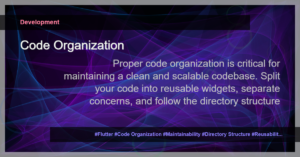10 Common Interview Questions and Answers for Flutter Developers
If you are a Flutter developer, chances are you will face technical interviews to showcase your skills and knowledge. To help you prepare, we have compiled a list of 10 common interview questions that are frequently asked in Flutter interviews. Along with each question, we will provide a detailed answer and code examples. Let’s dive in!
1. What is Flutter? How does it differ from other mobile app development frameworks?
Flutter is an open-source UI framework developed by Google for creating natively compiled applications for mobile, web, and desktop from a single codebase. It uses the Dart programming language and provides a rich set of pre-built widgets for building user interfaces. Flutter differs from other frameworks by its ability to create cross-platform applications with a high performance and native look and feel.
2. Explain the state management options in Flutter.
Flutter offers various state management approaches such as setState, Provider, BLoC pattern, Redux, and MobX. The choice of state management depends on the complexity of your app and personal preference. For small to medium-sized apps, setState can be used. For larger apps with complex state management needs, one can opt for Provider, BLoC pattern, Redux, or MobX.
3. How do you handle asynchronous programming in Flutter?
In Flutter, asynchronous programming is commonly handled using the Future and Stream APIs. The async/await keywords are used to write asynchronous code in a more readable and sequential manner. Flutter also provides a wide range of built-in methods and packages for handling asynchronous tasks such as network requests and database operations.
void fetchData() async {
try {
final response = await http.get('https://api.example.com/data');
if (response.statusCode == 200) {
final data = jsonDecode(response.body);
// Process the data
}
} catch (e) {
// Handle the error
}
}
4. How do you debug Flutter applications?
Flutter provides a powerful debugging tool called “Flutter DevTools” which allows you to inspect and diagnose your application at runtime. It provides features like inspecting widgets, analyzing performance, and viewing logs. Additionally, Flutter integrates well with popular IDEs such as Visual Studio Code and Android Studio, providing hot reload, breakpoints, and other debugging functionalities.
5. What are widgets in Flutter?
In Flutter, everything is a widget. Widgets are the building blocks of a Flutter application’s user interface. There are two types of widgets: stateless widgets and stateful widgets. Stateless widgets are immutable and their properties cannot change once created. Stateful widgets, on the other hand, can maintain state and update their properties dynamically.
6. Explain the concept of hot reload in Flutter.
Hot reload is a feature in Flutter that allows developers to quickly see the changes they make in the code without restarting the entire application. It significantly speeds up the development process since you can instantly see the visual changes in the app and test new functionality.
7. How do you perform navigation between screens in Flutter?
Flutter provides a navigation API to move between different screens or routes. The Navigator class is used to manage the stack of screens. Some common navigation operations include pushing a new screen onto the stack, popping the current screen from the stack, popping screens until a specific screen is reached, replacing the current screen with a new screen, and clearing the entire stack and starting with a new screen.
// Push a new screen onto the stack
Navigator.push(
context,
MaterialPageRoute(builder: (context) => SecondScreen()),
);
// Pop the current screen from the stack
Navigator.pop(context);
// Replace the current screen with a new screen
Navigator.pushReplacement(
context,
MaterialPageRoute(builder: (context) => NewScreen()),
);
8. How do you perform network requests in Flutter?
Flutter provides the http package, which is commonly used to make HTTP requests. You can use the get, post, put, delete, and other methods provided by the package to send HTTP requests to a server. Additionally, there are other popular packages like Dio and Chopper that offer advanced features for making network requests in Flutter.
void fetchData() async {
final response = await http.get('https://api.example.com/data');
if (response.statusCode == 200) {
final data = jsonDecode(response.body);
// Process the data
}
}
9. What are some commonly used packages in Flutter?
Flutter has a vast ecosystem of packages that extend its functionality. Some commonly used packages include http for making network requests, shared_preferences for local data storage, intl for internationalization, flutter_bloc for state management, google_maps_flutter for integrating Google Maps, and firebase_core for connecting with Firebase services.
10. How do you handle screen sizes and orientations in Flutter?
Flutter provides a responsive layout system that adapts to different screen sizes and orientations. You can use media queries to get information about the device’s screen size and adjust your UI accordingly. Additionally, Flutter offers widgets like OrientationBuilder, LayoutBuilder, and GridView to handle responsive layouts and support different screen orientations.
This concludes our list of 10 common interview questions and answers for Flutter developers. We hope these questions and the provided answers and code examples help you in preparing for your next Flutter interview. Remember to practice coding and explore the Flutter documentation to further enhance your skills. Good luck!






